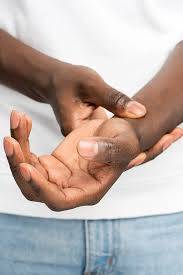Tendinitis
Tendinitis is the inflammation or irritation of a tendon, the thick fibrous cords that attach muscle to bone. It commonly affects tendons in the shoulders, elbows, wrists, knees, and heels. Tendinitis typically occurs from repetitive stress or overuse of a tendon, causing pain, swelling, and limited mobility. It can affect athletes, workers, or anyone performing repetitive movements.
---
20 Causes of Tendinitis
1. Repetitive Movements: Activities involving repetitive motions, such as typing, playing musical instruments, or sports like tennis.
2. Overuse: Excessive use of a particular tendon during physical activities, such as running or jumping.
3. Sports Injuries: High-impact sports like basketball, tennis, or running can strain tendons.
4. Poor Technique: Incorrect posture or form during activities can place stress on tendons.
5. Aging: Tendons become less flexible with age, making them more prone to injury.
6. Sudden Increase in Activity: Rapidly increasing the intensity or duration of physical activity can lead to tendinitis.
7. Occupation-Related Strain: Jobs that involve repetitive motion, such as construction work or factory labor, increase the risk.
8. Lifting Heavy Objects: Improper lifting techniques can strain tendons, especially in the shoulders and arms.
9. Joint Misalignment: Poor joint alignment can place undue stress on tendons, leading to inflammation.
10. Tight Muscles: Tight muscles can pull on tendons and cause inflammation.
11. Improper Footwear: Wearing unsupportive or inappropriate footwear during activities can strain tendons, particularly in the feet and ankles.
12. Flat Feet or High Arches: Foot structure abnormalities can put extra stress on tendons in the feet and legs.
13. Running on Hard Surfaces: Running on concrete or other hard surfaces can increase the risk of tendinitis, particularly in the knees or feet.
14. Previous Injuries: Tendons weakened from previous injuries are more likely to become inflamed.
15. Tendon Degeneration: Degenerative conditions like tendinosis can predispose someone to tendinitis.
16. Cold Weather: Cold temperatures can make tendons stiffer and more prone to injury.
17. Inflammatory Diseases: Conditions like rheumatoid arthritis or lupus can increase inflammation in tendons.
18. Calcium Deposits: Buildup of calcium in the tendons can cause irritation and inflammation.
19. Smoking: Smoking can reduce tendon health by decreasing blood flow and oxygen supply.
20. Infections: In rare cases, infections in or around tendons can lead to inflammation.
---
20 Signs and Symptoms of Tendinitis
1. Localized Pain: Sharp or aching pain in the affected tendon, especially during movement.
2. Swelling: Swelling or thickening around the tendon area due to inflammation.
3. Tenderness: Sensitivity to touch over the affected tendon.
4. Warmth: The inflamed area may feel warm to the touch.
5. Redness: Redness in the skin over the affected area.
6. Stiffness: Reduced flexibility and stiffness in the joint or tendon.
7. Pain with Movement: Increased pain during specific motions, such as lifting or running.
8. Cracking or Popping Sensation: The affected tendon may make a cracking or popping sound during movement.
9. Weakness: Weakness in the surrounding muscles due to tendon pain and inflammation.
10. Limited Range of Motion: Difficulty fully moving the joint associated with the inflamed tendon.
11. Shooting Pain: Sudden, intense pain when trying to move the affected tendon.
12. Numbness or Tingling: In some cases, nearby nerves may be compressed, causing numbness or tingling.
13. Thickened Tendon: The tendon may become visibly thickened over time.
14. Night Pain: Pain may worsen at night or during rest after activity.
15. Bruising: In rare cases, minor bruising can occur near the inflamed area.
16. Burning Sensation: A burning feeling in the affected tendon, especially during use.
17. Pain During Stretching: Stretching the affected tendon may cause pain.
18. Pain at Rest: In more severe cases, the tendon may be painful even when not in use.
19. Difficulty Grasping Objects: Tendinitis in the hand or wrist can cause difficulty gripping items.
20. Pain with Pressure: Applying pressure to the affected area increases discomfort.
---
10 Effects of Tendinitis
1. Chronic Pain: Ongoing pain in the affected tendon that can interfere with daily activities.
2. Limited Mobility: Reduced range of motion and flexibility in the affected joint or limb.
3. Reduced Strength: Weakened muscles surrounding the inflamed tendon due to disuse.
4. Loss of Function: Difficulty performing tasks that require the use of the affected tendon.
5. Tendon Rupture: In severe cases, untreated tendinitis can lead to a rupture, which may require surgery.
6. Permanent Stiffness: Long-term inflammation can lead to joint stiffness and reduced flexibility.
7. Increased Risk of Future Injuries: A weakened tendon is more susceptible to further injuries.
8. Scar Tissue Formation: Chronic inflammation may lead to the formation of scar tissue, which limits movement.
9. Mental Health Impact: Chronic pain and limited mobility can lead to anxiety or depression.
10. Need for Surgery: If tendinitis doesn't improve with conservative treatments, surgery may be required to repair the tendon.
---
Prevention of Tendinitis
1. Warm-Up Properly: Always warm up before engaging in physical activities to prepare your tendons and muscles.
2. Use Proper Technique: Maintain correct form during exercise, sports, and physical tasks to avoid unnecessary tendon strain.
3. Strengthen Muscles: Strengthen the muscles around tendons to support them and reduce the risk of injury.
4. Stretch Regularly: Incorporate stretching into your routine to improve flexibility and prevent stiffness.
5. Avoid Overuse: Gradually increase the intensity and duration of activities, and avoid repetitive movements when possible.
6. Take Frequent Breaks: Rest periodically during repetitive tasks to give tendons time to recover.
7. Use Proper Equipment: Ensure that sports gear, footwear, and tools are appropriate and ergonomic for your activity.
8. Cross-Train: Engage in a variety of physical activities to prevent overloading any single tendon.
9. Stay Hydrated: Proper hydration helps maintain tendon elasticity and overall joint health.
10. Treat Injuries Early: Address minor strains or discomfort promptly to prevent tendinitis from developing.
Preventing tendinitis involves taking care of your tendons by staying active, practicing good ergonomics, and addressing any early signs of inflammation before they worsen.


